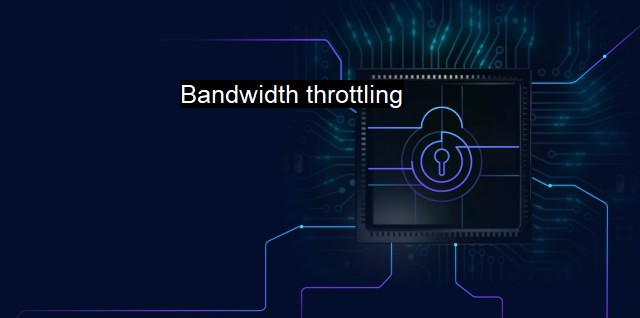What is Bandwidth throttling?
Effective Cybersecurity Strategies: Role of Bandwidth Throttling in Network Traffic Management
Bandwidth throttling is a deliberate regulatory technique carried out by Internet Service Providers (ISPs) to limit or manage network traffic and minimize bandwidth congestion. it has the potential to serve as both, a boon and a concern.ISPs use it as a method of ensuring fair distribution of the available bandwidth amongst users during peak load conditions. It involves limiting the speed of the internet service intentionally to prevent overuse of bandwidth and ensure that all users have access to stable internet connections. This is done by gauging the users' data quantity or scrutinizing the kind of content users access through the network. While these might be used as proper justifications by the ISPs, often, it is viewed as an invasion of privacy by the end users.
One major reason why bandwidth throttling is generally associated with cybersecurity concerns is due to ‘data packet inspection' or DPI. While carrying out the bandwidth throttling function, ISPs use DPI technology that allows them to delve into users' data packets. These data packets could contain sensitive information, including what websites the users visited and what kind of content they shared or accessed online. Unfortunately, when the ISPs' DPI process becomes a common knowledge among cyber criminals, they could exploit it and use it as a gateway to users' sensitive information. If successfully tapped, this could expose end users to data breaches, identity thefts, and other forms of online attacks.
Take the example of virus or malware that are infamous for occupying a lot of bandwidth, crippling the overall functionality and making system protection a challenge. Therefore, it becomes crucial for cybersecurity and antivirus platforms to identify and eliminate such threats actively to prevent bandwidth throttling and maintain a steady data flow meaning it inextricably ties both domains.
Antivirus applications have a critical role in protecting systems from such malicious entities by detecting, blocking, and removing them before they inflict any harm. They utilize stripe matching procedures, machine learning algorithms, and behavioral analysis to detect abnormal user behavior patterns that could indicate a potential threat, preventing it from happening at all.
When the system is free of malware that uses bandwidth rapidly, the chances of bandwidth throttling decrease. Therefore, maintaining a clean system not only safeguards sensitive and vital information but also ensures an efficient data flow.
It's also worth noting that antivirus programs, in corroboration with cybersecurity settings, can rectify and pre-empt any unauthorized bandwidth throttling introduced by harmful elements. Network encrypting technologies like Virtual Private Network (VPN), which protect data packets from being analyzed by ISPs, could also make strides towards preventing bandwidth throttling.
In practice, bandwidth throttling is primarily considered as a grey area in cybersecurity. Capping or decentralizing the internet speeds during particular times or to particular users could assure fair use but simultaneously leads to concerns about net neutrality. In this light, while it could be justifiably exploding the available internet resources, it could also potentially ooze into the domain of privacy invasions, leading to lethal end-results if not keenly monitored.
Anti-virus scanning services, technological security measures, and privacy tools, along with stringent cybersecurity norms, can assist in accentuating bandwidth speed, buffering cyber threats, and sanctioning optimum bandwidth usage. Therefore, finding the right balance and ensuring the right cybersecurity measures are in place makes the discussion around bandwidth throttling consistent, pertinent, and indeed, an increasingly seminal aspect in this digitized era.

Bandwidth throttling FAQs
What is bandwidth throttling?
Bandwidth throttling, also known as traffic shaping, refers to the intentional slowing down of internet connection speeds by internet service providers (ISPs) in order to regulate the flow of network traffic.Why do ISPs engage in bandwidth throttling?
ISPs engage in bandwidth throttling as a means of managing network congestion and ensuring that all users have equal access to the available network resources. It is also sometimes used by ISPs to restrict access to certain types of content, such as file-sharing services.Is bandwidth throttling legal?
Bandwidth throttling is generally legal, although rules and regulations surrounding throttling practices vary depending on the country and the type of ISP involved. In some cases, ISPs are required to disclose their throttling practices and obtain the consent of customers before implementing them.How can I prevent bandwidth throttling?
There are a number of ways to prevent bandwidth throttling, including using a virtual private network (VPN) to encrypt your internet traffic, choosing an ISP that does not engage in throttling, and monitoring your internet usage to ensure that you are not exceeding your allotted data allowance. It is important to note, however, that not all types of bandwidth throttling can be prevented.| | A | | | B | | | C | | | D | | | E | | | F | | | G | | | H | | | I | | | J | | | K | | | L | | | M | |
| | N | | | O | | | P | | | Q | | | R | | | S | | | T | | | U | | | V | | | W | | | X | | | Y | | | Z | |
| | 1 | | | 2 | | | 3 | | | 4 | | | 7 | | | 8 | | |||||||